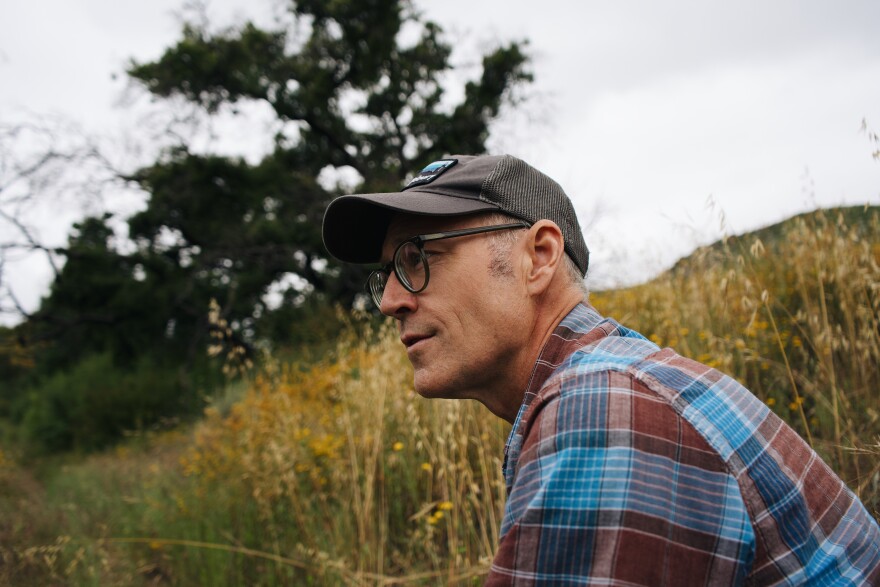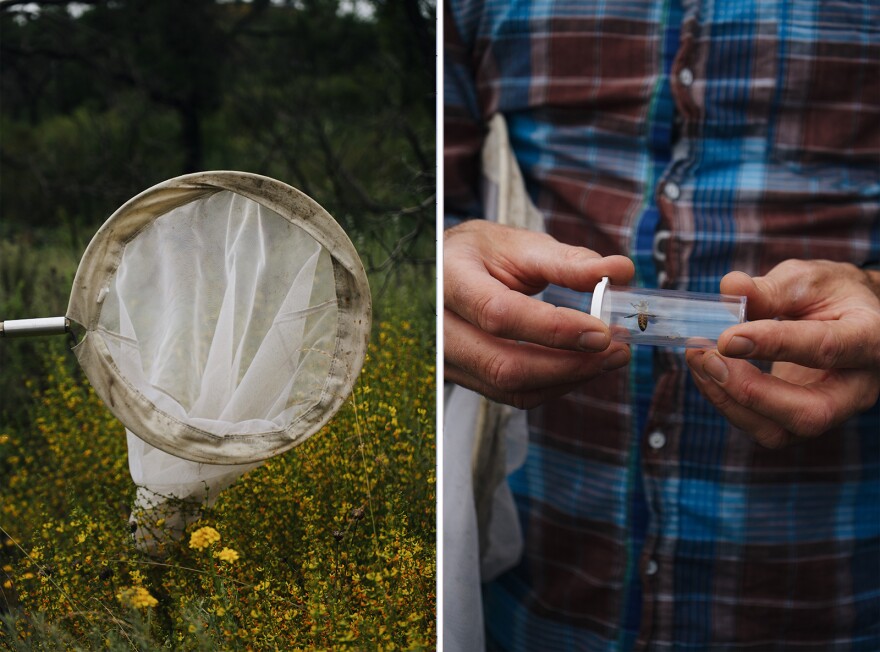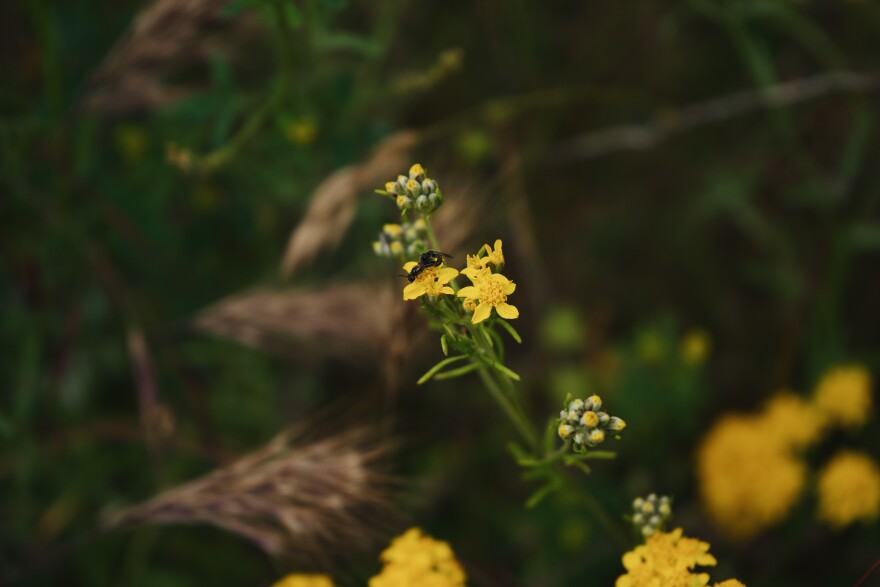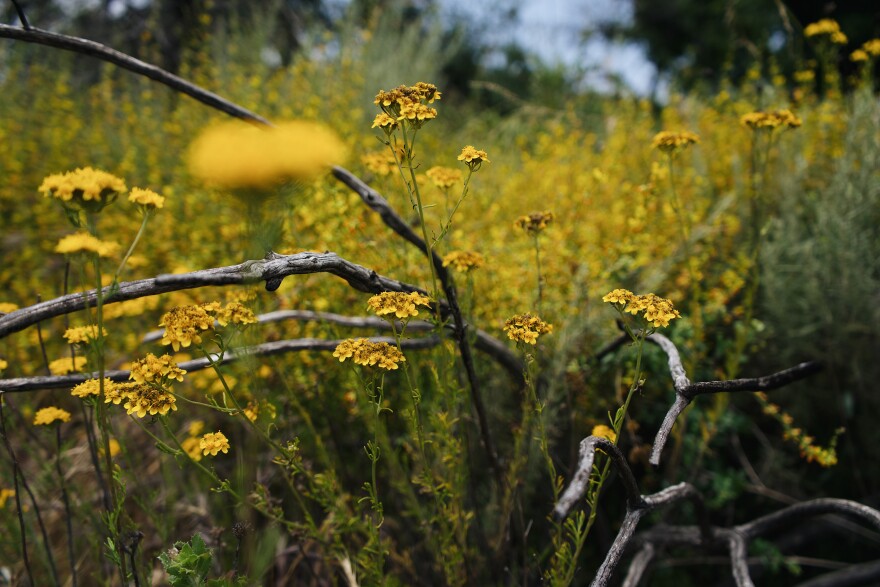I never realized how fuzzy a bumble bee is until I got to hold one between my fingertips. It feels like a furry black and yellow bear, buzzing with its tiny body, wriggling with its legs.
The conservation biologist Leif Richardson, who handed me this bee a moment ago, has some advice for holding it. "You're going to squeeze harder than you think you need to, but not so hard that you hurt him."
And luckily the bee can't hurt me either, because this is a male bee, and males don't have stingers. But they do have a scent, Richardson explains.
"Your fingers are going to smell like a male bee when you're done. It's a little like geraniums, a little bit cheesy, sort of like cheddar cheese in a way."
We are out in the wilds of far western Malibu, in the home range of a native bee called Crotch's Bumble Bee, or Bombus crotchii. That bee is protected by state law, and it's one of the many species under survey for the California Bumble Bee Atlas.

The Atlas is a sort of census for the state's bumble bees, and Richardson helps lead the project for the Xerces Society for Invertebrate Conservation. Over three years, hundreds of volunteers will fan out across the state to do surveys like this one, with the goal of piecing together a picture of where wild bees live, and which species are in trouble.
"This is real data of the highest quality that's been collected by these trained amateurs," Richardson says, "and it is the best available data we have for making decisions about the conservation and management of these very important animals."

Our journey begins at a mountain trailhead in Leo Carrillo State Park. It's a cloudy morning, and Richardson's dressed in a checkered flannel shirt, black-rimmed glasses, and a "Middlebury" cap. (He moved here recently from Vermont). We set off for a short hike, armed with bee nets, vials and a cooler to chill any bees we catch. It's a harmless way to temporarily sedate the bees, to allow for more careful study and snapshots.
Coastal sage scrub frames the trail, and poison oak is everywhere too, fresh from all the winter rain. Other dangers are harder to see. "I wanted to just say rattlesnakes are a possibility," Richardson warns.
Just a minute later, as he's wading into a meadow bursting with red and yellow deerweed – prime bumble bee habitat – I hear him yell out something unprintable, followed by "rattlesnake!" It's a huge, meaty snake, several inches thick, lying just a yard from his foot, its scales perfectly camouflaged against the brush. He stands there motionless for a moment, before backing away towards the trail, while the snake slithers off.
We're a little more sober about the possibilities now, as we prepare to catch our first bees. They're not hard to spot – I can hear them whizzing everywhere, in surround sound, and soon Richardson says it's time for me to catch one.

He tells me to pinch the tip of my net and hold it upright – like a witch's hat – while slowly lowering it over a flower where our bumble bee prey is foraging. As soon as the bee realizes what's going on, it buzzes furiously inside my net, and then slowly climbs up the fabric towards the tip – right where my finger is. Richardson tells me to grab the wide part of the net with my other hand, slowly choking my hand up the net until the bee is trapped in the tip.
It all seems like a really good way to get stung. But Richardson assures me I'll be fine – he says the bumble bees aren't likely to sting us, and he's got an EpiPen just in case. He tells me that my obsession with the stinger is not all that unique.
"A lot of people who want to participate in the California Bumble Bee Atlas, their first question is really, will I get stung?" He points out that a lot of people tend to think of bees only in terms of the danger they pose to humans – rather than seeing them as whole animals, with interesting lives and behaviors.
"They have this rich ecological life history. They have interesting mating biology," he says. "Another one is social biology. The biology of the nest is absolutely fascinating and it gives us a model for understanding social behavior in other bees and also other insects and vertebrates like us. There's a ton of interesting things about bees, if you look beyond the hypothetical dangers of being stung by one."

Talking to Richardson, it feels easy to look beyond those hypotheticals. But the next step in this bee-catching process seems far from a hypothetical. Richardson tells me to insert a small plastic vial up into the net with my bare fingers, right where the bee is, and somehow convince it to "fall" inside the vial, before popping a cap on. As my fingertips get closer to the bee, it feels like I can hear it buzzing louder and louder.
Richardson performs this whole process in seconds, by the way, with the confidence of someone juggling blindfolded. For me, on the other hand, it's a grueling act of intense concentration. But it pays off – and soon, I've got my very first bee!
It's that male I mentioned earlier. His yellow hair is the color of a hard-boiled egg yolk, and as we hold him, Richardson points out the bright bushy beard on his face – one of the telltale signs of a male. But he wriggles out of our hands before we can get him back in the vial – perhaps in search of queens.

We too are in search of queens, as Richardson reminds me, and still hoping to find that species he mentioned – Crotch's bumble bee – so we head back down the trail to another meadow.
As we head up a hill of dry brush, we pass by big plumes of purple sage, and Richardson suddenly sweeps into action, his net flying through the air with an acrobatic swing and twirl. A second later we hear an enormous buzzing from the net – he's netted something big.
It turns out he's caught not one, but two Bombus crotchii – and one of them's a queen! Then the bee transfer begins. "So this is a way people get stung. I have a bee in the vial and a bee in the net ... so my fingertips are in there with the extra bee." But he's a pro – he does this literally thousands of times a year – so no stings here.
He tucks the queen into a vial with a sprig of sage flowers, and just as we're all admiring this regal bee, I start to feel a tingling sensation in my leg – almost like my skin is crawling. I look down, and realize in horror that there are hundreds of thick black ants streaming up my leg, outside my pants, but inside too. I must have stepped on a nest during the excitement.

The ants have reached my back and backpack as well, and it feels like they're starting to latch onto my skin. Richardson, ever-mindful of the queen, stashes her in a cooler, as I furiously brush the ants off my pants and skin. It takes about 10 minutes of vigorous brushing to get them off, and I still find a few in my shoe later on down the trail.
Being stung may have been my top concern starting out this morning, but clearly the mountains had other hazards in mind. And the dangers we encountered today on this small sampling expedition are a vivid reminder of the sheer scale and ambition of this project.

Surveys like this are happening in more than 250 parts of California, with the help of twice that many volunteers. And this California project is part of a much larger continent-wide Bumble Bee Atlas, which stretches from Alaska to Maine to Georgia. About a quarter of North America's 50 bumble bee species are at risk, according to the Xerces Society, and Richardson says this huge constellation of surveys is one of the best tools scientists have for guiding the conservation of these charismatic animals.
"There's intrinsic value to these native animals that occur here and have been here co-evolving with these plants for millennia," he says. But beyond that – for those who might need another reason to care about wild bees – he points out their value as pollinators of wild plants and crops.
"These wild bees are tremendously important to maintenance of healthy ecosystems, which human beings depend on, and to the human food supply, which we obviously depend on. So we've got both utilitarian and kind of intrinsic reasons to conserve bees."

The magnificent queen bee is still sitting on ice in the cooler, and as we walk back to the car, it's time to photograph her, and let her go. Richardson gently dumps her into the palm of his hand, along with the worker bee he caught with her. At first they just lie there, groggy, and we slowly pet the hairs on the queen's back.
She's waking up fast though, and pretty soon we hear an energetic fluttering from her wings, before she lifts off into the sky. "They're really good at using landscape features to find their way," Richardson says. She circles a few times, before zooming off towards the sage where we caught her.
And thus, our queen journeyed home unharmed – and thankfully, so did we.
Ailsa Chang and Jonaki Mehta contributed to this report. contributed to this story
Copyright 2023 NPR. To see more, visit https://www.npr.org. 9(MDA4MzU1MzUzMDEzMTkyMzAwMzY5MjY1Mw004))




